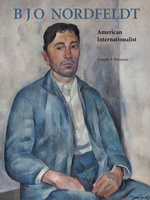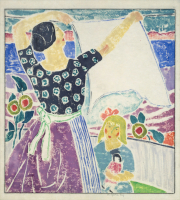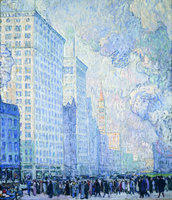B.J.O. Nordfeldt: American Internationalist
Reviewed by Rachel Epp BullerDr. Rachel Epp Buller
Professor of Visual Arts and Design, Bethel College
2021–22 Fulbright Canada Research Chair in Arts
Email the author: rebuller[at]bethelks.edu
Citation: Rachel Epp Buller, exhibition review of B.J.O. Nordfeldt: American Internationalist, Nineteenth-Century Art Worldwide 21, no. 1 (Spring 2022), https://doi.org/10.29411/ncaw.2022.21.1.16.
This work is licensed under a Creative Commons Attribution-NonCommercial 4.0 International License  unless otherwise noted.
unless otherwise noted.
Your browser will either open the file, download it to a folder, or display a dialog with options.

B.J.O. Nordfeldt: American Internationalist
Weisman Art Museum, Minneapolis
June 18–September 5, 2021
Wichita Art Museum, Wichita
September 25, 2021–January 16, 2022
Catalogue:
Gabriel Weisberg, ed., with texts by Janet Whitmore, Annika Johnson, and Paul Kruty,
B.J.O. Nordfeldt: American Internationalist.
Minneapolis: University of Minnesota Press, 2020.
152 pp.; 250 color illus.; notes; index.
$39.95 (hardcover)
ISBN-13: 978–1–5179–0973–4
Barbara Thompson,
B.J.O. Nordfeldt: American Internationalist in Wichita.
Wichita: Wichita Art Museum, 2021.
26 pp.; 13 color and 19 b&w illus.; notes.
$10 (paperback)
So often when one attends a retrospective exhibition, one walks away with an overarching impression of an artist’s style. Perhaps there were some early works that showed experiments and forays in a range of directions, and perhaps, too, there were some late-career works not as strong as the rest, but the long middle period frequently coalesces into a recognizable style of aesthetic choices. Not so with the work of B.J.O. Nordfeldt, whose retrospective was organized by the Weisman Art Museum and then exhibited at both the Weisman and the Wichita Art Museums. In B.J.O. Nordfeldt: American Internationalist, we come to see that Nordfeldt’s career had little aesthetic consistency. In fact, as I walked through the exhibition, I heard a fellow visitor asking their companion, “Are these all by the same artist?” As the exhibition makes clear, Nordfeldt’s entire career was one of experimentation, trying out a wide range of Modernist styles while also speaking to the influence of the many locations in which he lived.
Born in Sweden, Bror Julius Olsson Nordfeldt emigrated to the United States with his family as a young teenager. So began a lifetime of wanderlust, a pattern of moving around that simultaneously defined the trajectory of Nordfeldt’s career as he encountered and engaged with myriad contemporary artists and art movements. Nordfeldt studied briefly at the Académie Julian in Paris, moved to London to learn woodblock printmaking, studied and later taught at the Art Institute of Chicago, returned to Paris and focused on etching, moved to New York, spent summers at the Provincetown Art Colony in Massachusetts, settled in New Mexico for two decades, accepted a series of teaching engagements in Utah, Kansas, and Minnesota, and spent his late years in Lambertville, New Jersey, near the artist colony of New Hope, Pennsylvania. In each of these places, Nordfeldt opened himself up to learning, from other artists in the region as well as from the landscapes around him.
The chronological arrangement of the exhibition highlights not only Nordfeldt’s movements from place to place but also the ways that he tried out different artistic styles, one after another. In Harvesting (1899) and Steamship in Canal—Venice (1910), Nordfeldt made use of Impressionist mark-making, with broken color treatment of the farmland and water. In Jackson Park, Chicago (1912), referencing a progressive arts district in the city, the figures dissolve into strokes of paint while the main focus becomes the play of light and color on the trees.
During the same years, Nordfeldt sought out the language of Expressionism. Untitled (Farm Woman), a charcoal drawing from 1901, exhibits gestural, Kollwitz-like linework. Double-hung with the drawing is an undated drypoint print, The Forge, Engelhom, whose dark interior and strong value contrasts intensify the Expressionist effect. One of the highlights of the show is a selection of portraits from the 1910s that appear indebted to Henri Matisse’s Green Stripe (1905, Statens Museum for Kunst, Copenhagen) and other Fauvist portraits incorporating non-naturalistic color. The faces of Nordfeldt’s models become surfaces for patches of unexpected colors, which he visually connects to the nuanced layering of open, brushy backgrounds. In one standout portrait unfortunately not reproduced in the catalogue, the sitter of Robert Friedel (1911–12) occupies the far right of an asymmetrical composition, the green shadows of his flesh subtly blending with the pale yellow-green painterly ground.
A small section of the exhibition showcases Nordfeldt’s attempts to learn mokuhanga, emulating the Japanese ukiyo-e prints that gained popularity across Europe in the late nineteenth century. Exhibited in close proximity to more energy-filled Impressionist and Expressionist works, Nordfeldt’s early multi-block woodcut prints suffer by comparison, with dull colors and some imprecise block registration. Perhaps the process was only a passing interest for the artist. And yet, the works set the stage for his future printmaking experiments.

A decade later, following a more successful and sustained foray into etching, Nordfeldt returned to relief prints and developed a white-line, single-block method of printing color woodcuts. In prints like Monday Morning (1916), we see how Nordfeldt hand-painted each section with its own color, then separated sections with a small carved line, which remained white when printed (fig. 1). This resulted in a full-color work taken from a single block in one printing. Nordfeldt and several peers pioneered this method during their summers at Provincetown, and white-line woodcuts are now sometimes called Provincetown prints. Because they are hand-painted, however, each resulting print is a single entity, essentially a monoprint, unlike most woodblock methods that yield multiple, editionable prints. The exhibition displays one of Nordfeldt’s carved blocks alongside several of his white-line prints, in a bid to help viewers understand the process.
Lured in part by other US artists who had made their home in the Southwest, Nordfeldt spent much of the 1920s and 1930s in Santa Fe, New Mexico. His works of this period clearly show the influence of place, with ubiquitous square adobe structures populating hilly landscapes. Some of them also exhibit Nordfeldt’s fragmentation of landscapes into flat patches of color, like the Cezannesque background of Antelope Dance of 1919. The stylized, faceless figures of Hopi dancers in the foreground call to mind contemporary European depictions of Otherness, although the label couches his stylization in terms of the Hopi prohibition of photography, clarifying that Nordfeldt likely would have painted the scene from memory.
Despite an apparent attempt to try out nearly every Modernist style, Nordfeldt studiously avoided social or political commentary, even in the 1930s when many of his peers in the US addressed the widespread despair caused by the Great Depression. His choice of subject matter—portraits, landscapes, and still life scenes—facilitated this avoidance. Given Nordfeldt’s predilection for emulating popular styles, it might seem surprising that he largely sidestepped the labor concerns of American Scene painting. An untitled 1933 lithograph of railroad workers is the closest Nordfeldt came to picturing labor or making any reference to class differences. A group of men in overalls pause in the midst of their work, crouching or leaning on shovels, while factories behind them spew smoke into the Wichita skyline. Catalogue essayist Annika Johnson proposes that this print may have been funded by the New Deal’s Federal Art Project, prompting Nordfeldt’s thematic shift (52). The only other depictions of labor on view stem from Nordfeldt’s time in New Mexico. In works like Untitled (Pack Train) (1919–39) and Teamsters Evening (Billy Pot) (1919), Nordfeldt’s generalized brown bodies become part of the landscape, figurative shapes of color rather than any form of class critique.
A late-career Self-Portrait (1940) aptly symbolizes Nordfeldt’s years of stylistic experimentation, even as it includes fictional elements. Nordfeldt painted himself in a jacket, vest, and tie, unlikely studio attire, and he eyes the viewer with a pipe hanging out of his mouth. Behind his naturalistically painted figure, the background dissolves into an abstraction of color. Nordfeldt holds a palette and paintbrush, apparently at work on the canvas shown. While his paintings always remained representational, he would surely have been aware of the many ways that Expressionists, Cubists, and other contemporaries more fully embraced abstraction. The canvas within the canvas of his self-portrait, with its abstract composition of color patches, may have offered a safe way for Nordfeldt to continue his stylistic experiments without committing to a complete abandonment of representation.
A beautiful, full-color, scholarly exhibition catalogue delves deeply to examine Nordfeldt’s life and work. Gabriel Weisberg, one of the chief organizers of the retrospective and publication, offers a thorough biographical essay, contextualizing Nordfeldt’s artistic journey in terms of place and people. Weisberg connects Nordfeldt’s forays to specific peers and mentors who led his painting in new directions, or inspired him to settle for a time in new locations. The essay also includes reproductions of several works not in the exhibition, visually expanding the story.

An essay by Janet Whitmore situates Nordfeldt in the context of Modernist Chicago (fig. 2). In the first few pages, Whitmore focuses on contentious architectural debates as the city prepared to host the 1893 World’s Columbian Exposition. She makes little mention of Nordfeldt, whose family may not have even attended the WCE. Whitmore’s purpose eventually becomes clear as she sets Nordfeldt, during his student days at the School of the Art Institute of Chicago, as a defender of modernism, in opposition to the Beaux-Arts tradition revived in large part due to the WCE. She connects him to the politically and socially progressive Jackson Park art scene, to which he made reference in an early painting, and notes the opportunities this connection later opened up for him in theater set and costume design. While some of the histories Whitmore traces read as tangential, including a detailed accounting of the Thurber Gallery at which Nordfeldt once exhibited, the overall effect is to offer a sense of place at a particular moment in time, a glimpse of Chicago during Nordfeldt’s formative years. A high point of the essay is a series of delicate architectural etchings by Nordfeldt of his Chicago surroundings, almost none of which are included in the exhibition.
While the majority of the exhibition and catalogue focus on Nordfeldt’s paintings, Annika Johnson devotes her essay to the printmaking side of his career. In many ways, Johnson’s essay is a parallel to Weisberg’s, for both writers chronologically explore the influence of place on the artist’s work, albeit in different media. Johnson begins with Nordfeldt’s forays into color woodcuts, heavily influenced by the Edo Period prints he encountered in Europe, but she makes clear that etching became Nordfeldt’s favored print medium. His etchings reflected his travels, souvenirs of France, Italy, Spain, and Morocco. Etchings accompanied him on his return to the US, in cityscapes and landscapes as he moved from place to place, with a brief interlude for white-line woodcuts. Always one to try new things, Nordfeldt learned lithography in the 1920s and pursued it into the following decade, at which point he gave up printmaking to focus exclusively on his painting.
Finally, an essay by Paul Kruty explores the relationship of Nordfeldt and his second wife, Emily Abbott. Abbott first met Nordfeldt when she was his painting student at the Minneapolis School of Art, and in the following years he encouraged her painting career from afar. A decade later and after the dissolution of his twenty-five-year marriage to Margaret Doolittle, Nordfeldt returned to Minneapolis in the company of Abbott. While Kruty notes Nordfeldt’s support of his wife’s painting, and reproduces a few of her artworks, the “enduring partnership” of his essay title is primarily the story of a widow’s devotion. Twenty-two years his junior, Abbott worked tirelessly after Nordfeldt’s death to promote his legacy. As Kruty writes, “During the next thirty-four years she was to devote herself to finding homes for the hundreds of Nordfeldt works in the barn and house, while working to ensure that Nord was awarded what she felt was his rightful place in the history of American art” (62). She developed a close relationship over a course of years with the Weisman Art Museum and her eventual bequest is the foundation for this retrospective.
Echoing Nordfeldt’s peripatetic career, the Wichita Art Museum is an appropriate second venue for the exhibition, as Nordfeldt returned again and again to the city. He taught regularly at the Wichita Art Association (now Mark Arts). He developed fast friendships with Wichita artists William Dickerson and C.A. Seward, among others, and Wichita was where he learned lithography, one of the many modes of printmaking that drew his interest. These ties are highlighted in a second, smaller companion exhibition and publication, B.J.O. Nordfeldt: American Internationalist in Wichita. The display and brochure showcase prints from the Wichita Art Museum’s collection not included in the traveling exhibition, and tell a Wichita-specific story by positioning Nordfeldt among his Kansas contemporaries. Arranged by subject matter categories of portrait, still life, and landscape, works by Dickinson, Seward, and Edmund Davison are juxtaposed with works by Nordfeldt to indicate potential cross-fertilization and artistic inspiration between friends. The brochure’s essay by Barbara Thompson offers a concise overview of Nordfeldt’s life and work, as well as his Wichita connections, that may prove accessible to viewers less interested in reading the larger exhibition catalogue.
The retrospective of B.J.O. Nordfeldt’s career paints a picture of a lifelong learner, always on the lookout for new ideas from other artists and from the varied urban and rural landscapes he inhabited. The lack of a singular style means that museum viewers are unlikely ever to recognize “a Nordfeldt” in the way that they might “a Monet.” Nordfeldt’s career hinged on never settling down, aesthetically or geographically, and the curators and essayists invite us to follow along on his winding paths.